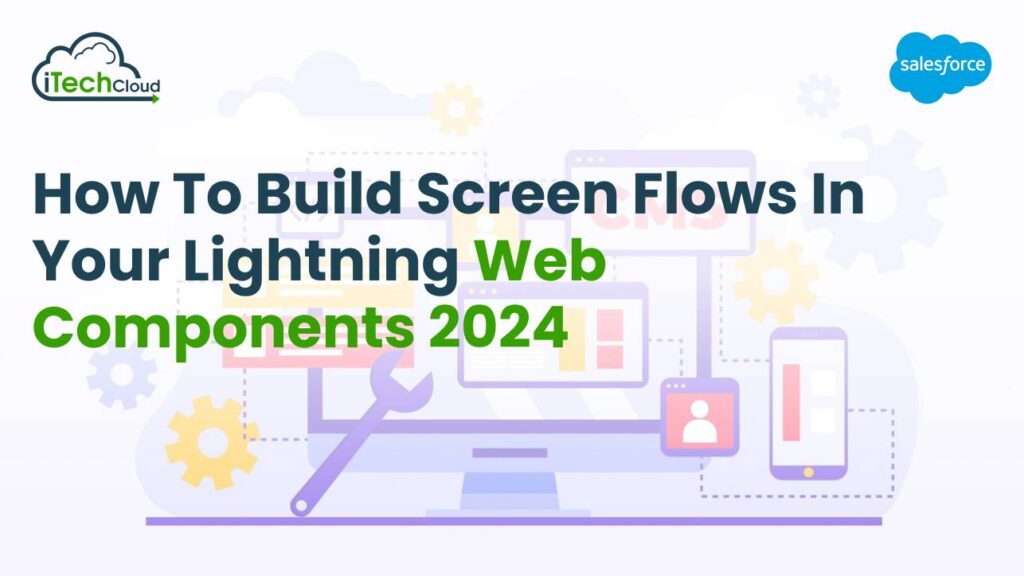How to Build Screen Flows in Your Lightning Web Components 2025

Building screen flows in Lightning Web Components (LWC) involves creating dynamic user interfaces for guiding users through a sequence of steps. These flows streamline processes and enhance user experience. By leveraging LWC, developers can design responsive and interactive screens within the Salesforce Lightning platform. Key components such as Lightning Flow and Flow Screen LWC facilitate the construction of these flows, enabling developers to design intuitive interfaces for various tasks like data entry, approvals, and onboarding. This tutorial will explore the fundamentals of constructing screen flows in LWC, empowering developers to create efficient and user-friendly applications.
Table of Contents
Introduction to Screen Flows and Lightning Web Components:
Screen flows are a visual representation of a series of steps that guide users through a process or task. They are commonly used in Salesforce to streamline complex processes and enhance user experience. Lightning Web Components, on the other hand, are a modern UI framework for building web applications on the Salesforce platform. They offer a component-based architecture that promotes reusability and maintainability.
Setting Up Your Development Environment:
Before diving into building screen flows with Lightning Web Components, it’s essential to set up your development environment. This involves having access to a Salesforce Developer Edition or Sandbox org and installing the Salesforce CLI on your machine. Additionally, ensure that you have a code editor configured with Salesforce extensions, such as Visual Studio Code with the Salesforce Extension Pack
Understanding the Basics of Screen Flows:
Screen flows consist of multiple screens, each representing a step in a process. These screens can contain various components, including standard Salesforce components like input fields and picklists, as well as custom Lightning Web Components. The Salesforce Flow Builder provides a drag-and-drop interface for designing screen flows, making it easy to create complex user interfaces without writing code.
Integrating Lightning Web Components into Screen Flows:
One of the strengths of Lightning Web Components is their seamless integration with screen flows. To integrate an LWC into a screen flow, you can simply add a custom Lightning component screen to your flow and select the desired LWC from the available components. This allows you to leverage the power and flexibility of LWCs to create custom user interfaces within your flows.
Building Custom Lightning Web Components for Screen Flows:
While Salesforce provides a rich set of standard components for use in screen flows, there are often cases where custom components are needed to meet specific requirements. Lightning Web Components offer a straightforward way to build custom components tailored to your needs. When building custom LWCs for screen flows, it’s essential to follow best practices such as encapsulation, reusability, and performance optimization.
Leveraging Events for Communication Between Components:
In complex screen flows where multiple components need to communicate with each other, events play a crucial role. Lightning Web Components support both standard and custom events, allowing components to communicate effectively without tight coupling. By leveraging events, you can create modular and loosely coupled components that are easier to maintain and extend.
Handling User Input and Validation:
User input is a fundamental aspect of screen flows, and proper validation is essential to ensure data integrity and user experience. Lightning Web Components provide built-in mechanisms for handling user input and performing validation, such as lightning-input and lightning-combobox. Additionally, you can implement custom validation logic using JavaScript and Apex to enforce business rules and constraints.
Implementing Navigation and Flow Control:
Navigation and flow control are critical aspects of screen flows, allowing users to progress through the steps of a process in a logical and intuitive manner. Lightning Web Components provide various navigation elements such as lightning-button and lightning-navigation, which can be used to navigate between screens and control the flow of the process. Additionally, you can use JavaScript to implement custom navigation logic based on user input and business rules.
Testing and Debugging Screen Flows:
As with any software development project, testing and debugging are essential steps in the development lifecycle. Salesforce provides tools and utilities for testing and debugging screen flows, including the Flow Builder debugger and the Lightning Web Components testing framework. By writing unit tests for your components and thoroughly testing your screen flows in different scenarios, you can ensure a high level of quality and reliability.
Conclusion:
Building screen flows with Lightning Web Components in 2025 offers a powerful and flexible approach to designing interactive and intuitive user interfaces on the Salesforce platform. By leveraging the capabilities of LWCs and following best practices for development, you can create engaging and efficient screen flows that enhance the user experience and drive productivity. With the continuous evolution of web technologies and the Salesforce platform, the possibilities for building innovative and impactful applications are endless.

